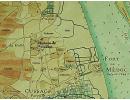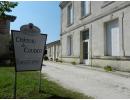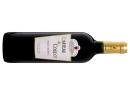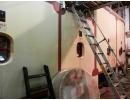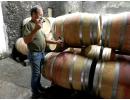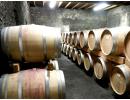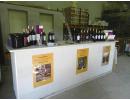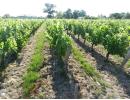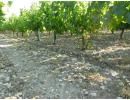Chateau de Coudot
Château de Coudot Cru Artisan - Haut Médoc
The wine is a blend of 55% Cabernet Sauvignon, 40% Merlot and 5% Cabernet Franc, this may vary slightly depending on the vintage. The 30 year old vines produce an average yield of 45 hl/ha. The winemaking is classic, after the sorting the grapes are destemmed, each grape variety will be fermented separately in concrete vats of various sizes from 50 to 165 hectolitres depending on the parcel's size. The Fermentations last 4 to 5 weeks at 28°C. The wine is aged in french oak barrels for 12 months with 1/3 of new oak each year.
PVins notes: Dark red in colour, expressive characteristic of ripe red fruit with hints of vanilla, dense and generous, well structured, slightly spicy on the palate, well intergraded oak with soft tannins on the finish. The wine may be cellared for up to 10 years depending on the vintage.
Château de Coudot is located on the commune of Cussac Fort Médoc, located between the appellations of Margaux and Saint Julien. For almost 2 centuries, the lieu-dit Coudot in the commune of Cussac Fort Médoc has always been known for its many Crus Artisans producers. In 1850, about 10 producers were mentioned as Cru Artisan in the commune of Cussac, but since the last classification only one remains as Château de Coudot owned by the Blanchard family. Today, 36 estates are classified in the whole Médoc sub-region. Some of the conditions to be classified are: the estate must be a family business, the wine must be estate bottled and wines produced must be tasted and approved by a panel every year.
In 1949, the 9th Féret publication of Bordeaux and its wines mentions the only remaining Cru Artisan at Coudot owned by Mr and Mrs Pineau the grandparents of the current owner Joël Blanchard. At the time the estate was producing 10 barrels of wine. In 1960, the property was taken over by the mother of Joël. After four years of hard work, 1964 was the first vintage bottled at the estate under the name of Domaine de Coudot. In 1966-1967 a consolidation of the many plots puts an end to the excessive fragmentation of the domain. The estate was now made up of 7 parcels representing 2.5 ha and Domaine de Coudot is now ready to expand.
In 1981, when Joël the eldest of 3 sons in the family Blanchard finished his studies in viticulture and oenology, the property had expanded to 4.5 ha. With the help of a government loan for "young farmers", Joël Blanchard acquired a further 6 hectares of vineyards of which 1.5 ha was already planted with old vines. In 1987, the family estate and the land acquired by Joël were regrouped under the name Château de Coudot. Today, the vineyard represents 11.25 ha and produces on average 40,000 bottles under the label of Cru Artisan validated by the official ranking of 2018.
Château de Coudot represent 11.25 ha made up of 15 parcels on the commune of Cussac Fort Médoc in the Haut Médoc appellation. The premier vin Cru Artisan represents 9.70 ha while the remainder is part of a second label created in 1989 following a new parcellaire approach by Joël. One of the parcels is in the heart of the village were the cellar is located, here the soil is composed of sand, clay with some gravel. The majority of the parcels are located next to each other between the village and the Fort on the edge of the Gironde, in this area the terroir is similar to Saint Julien set on a terrace composed of gravel called "graves garonnaises".
The red grape varieties planted are classic for Bordeaux which are Cabernet Sauvignon, Merlot and some Cabernet Franc. The vines are planted at a high density and are of an average age of 30 years old. Grass is grown between the rows for bio-diversity and natural health of the vineyard. Canopy management and green harvest are practiced when necessary. Since 1994 the harvest is machine picked to enable a shorter harvesting time and pick the grapes at their optimum maturity. Before the picking the unwanted bunches will be removed from the vines and another sorting will be done at the cellar on arrival.
The winemaking is classic for Bordeaux, the grapes are destemmed and each grape variety will be fermented separately in concrete vats of various sizes from 50 to 165 hectolitres depending on the size of the parcel. The average yield is 45 hl/ha. The Fermentation will last 4 to 5 weeks at 28°C. The wine will then be aged in French oak barrels for 12 months with 1/3 of new barrels each year.
Links: AOP Haut Médoc - Médoc map - Bordeaux map
HAUT MEDOC
The Haut Médoc appellation created in 1936, is located to the northwest of Bordeaux on the vast Médoc peninsula situated on the left bank of the Gironde estuary. Its southern edge borders the city of Bordeaux at Blanquefort and stretches for about 60 kilometres to the Médoc appellation north of Saint Seurin de Cadourne covering 15 communes exclusive to the appellation. Within its borders there are 6 communal appellations: Margaux, Saint-Julien, Pauillac, Saint-Estéphe, Listrac-Médoc and Moulis-en-Médoc. Here you will find some of Bordeaux’s most prestigious wines following the 1855 Grand Cru Classé classification such as Château Margaux, Mouton-Rothschild, Lafite and Latour. The appellation Haut Médoc has 5 Grand Crus Classés (growth wines) of its own.
Haut Médoc - 1855 Grand Cru Classé classification:
3rd Growth: Château La Lagune.
4th Growth: Château La Tour Carnet.
5th Growth: Château Belgrave, Château de Camensac, Château Cantemerle.
History
It is believed the vineyards might have begun sometime after 43 AD, during the Roman occupation of Gaul. The few plots of vines were concentrated around Bordeaux and the Médoc was known above all for its forests, its marshy meadows and fields of rye. Later in the early Gallo-Roman period, the Celts from the Bourges region founded Burdigala (Bordeaux) which subsequently became the capital of Aquitaine Gaul. But before the Middle Ages, it cannot really be said that there was any vine-growing in the Médoc. During the early Middle Ages, religious communities and feudal lords started planting vines around the priories (Macau, Cantenac, Vertheuil, the Abbaye de l’Isle) and manor houses (Castelnau, Lesparre, Latour and Blanquefort). These modest micro-vineyards produced new wines called 'Clarets' that were much appreciated by the English. Despite these few vineyards scattered throughout the Médoc, the main vine growing activity was centred in and limited to the southern Médoc, mainly in marshy soils but also in gravel. In the course of the 16th century, leading figures created estates devoted to mixed farming and stock rearing. In the 17th century, Dutch merchants began an ambitious drainage project to convert the marshland into a usable vineyard area. Using technology that was advanced for that time, the Dutch were able to convert enough marshland to allow large estates to form all along the Gironde. Soon the Bordeaux wine regions of Margaux, Saint-Julien, Pauillac and Saint-Estèphe took shape. The growers sought to improve their knowledge of the terroirs. They very rapidly established that there was a direct relationship between the soil and the quality of the wine. In 1709, the Great Winter destroyed all the vineyards. The growers gradually replanted their vineyards with noble grape varieties and observed that alignment of the vines facilitated the care of the vines and offered greater possibilities for ploughing producing better quality grapes. As the same time, improvements were made to the vinification techniques. By the 19th century, the wine region of the Haut-Médoc was one of the most prosperous in France. However, this unstoppable pioneering spirit was however stopped dead in its tracks with the arrival of the phylloxera between 1865 and 1892. The plague-like attacks wiped out the vineyards and it took more than 30 years to replant the Médoc thanks to the use of American rootstocks which were naturally resistant to phylloxera. Since the 1960’s, a fantastic renaissance with the modernisation of the estates, the progress achieved in oenology and above all the work and passion of the people Bordeaux has been able to shine again internationally.
Vineyard
The Médoc peninsula, created by water is an entirely sedimentary region. Some 50 million years ago, the Aquitaine Basin was a vast tropical sea. Over the centuries, the surging waters drained vast quantities of sedimentary deposits which gradually accumulated to form the soils and sub-soils of the Médoc. Over the last million years of the Quaternary era, gravel from the Garonne and Dordogne rivers were brought by the powerful currents washed down from the melting glaciers upstream in the Pyrenees and the Massif Central. The resulting variation in types of soil is greater than other appellations in the region, ranging from less than ideal terrain, to conditions on a par with some of the appellations of more celebrated reputation. In summary, the terroir is mainly composed of layers of Garonne gravel (graves garonnaises) with limestone and clayey-sand. The best soils tend to be located along the estuary were the gravel is predominant, this explains the concentration of the 1855 Cru Classé in these areas.
The appellation's vineyards cover approximately 4,650 hectares representing about 28% of the vineyard surface in the Médoc peninsula. The vines are planted at a high density which can reach 10,000 vines per hectare. The varieties planted under the appellation's regulation are Cabernet Sauvignon representing about 52% of the vineyard, Merlot, Cabernet Franc, Petit Verdot and to a small degree Malbec (locally called "Cot") and Carménère. Cabernet Sauvignon is ideally suited to gravely soil, it produces a wine full of finesse with a remarkable bouquet and outstanding cellaring potential. Thanks to its deep roots, it is very resistant to drought, it needs dry, perfectly well drained soils in which it can drive its roots deep down to draw up the necessary nourishment for the production of its tannins. The Merlot brings roundness, fruitiness, freshness and mellowness. Planted in large quantities in the Médoc, it develops particularly well in clayey-limestone and gravely soils. The Cabernet Franc found in smaller proportions generally prefers clayey soils. It brings a light, brilliant colour and a very rich bouquet to the wine. Petit Verdot, with its delicate fragrance of violets, serves to enliven the wines bringing colour, alcohol and a touch of acidity. As for the Malbec and Carmenère, they are complementary varieties that are rarely used bringing some interesting additional nuances in the blend.
Climate
The Médoc peninsula is situated between the Atlantic and the Gironde estuary on the 45th parallel, which partly explains its temperate climate. Relatively warm and humid, with regular sunshine, the Médoc benefits above all from gentle, soft breezes. The relatively strong winds blowing in from the Atlantic are slowed down by a pine forest. The Atlantic winds mingled with those from the estuary creating an excellent circulation of air which protects the vineyards from late spring frosts and diseases. The Atlantic Ocean and estuary both play an important part in regulating the temperature of the peninsula creating a range of climatic variations and different microclimates. Generally speaking, the rain comes between autumn and spring and statistically, it can be said that summers in the Médoc are relatively hot and dry especially when exceptional vintages are produced.



